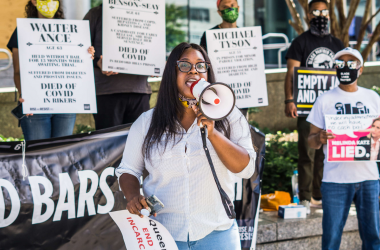After 13 years of living in the same place, an apartment that I, with the help of many friends and community members, have built bit by bit (and bathroom fixture by bathroom fixture), I’m moving. It’s been a tedious and sometimes painful process to sort 13 years worth of belongings and prepare to say good-bye to 13 years worth of memories.
I recently received a letter from a woman imprisoned in Michigan who had shared many of her stories and experiences for Resistance Behind Bars. The state of Michigan closed the Robert Scott Correctional Facility this past May and transferred all 800+ women to the Huron Valley prison (which had been a men’s prison with the capacity to hold 400 men). Her (and many other women’s) ordeal in both moving and continuing the adjust to the substandard and inhumane living conditions at Huron Valley definitely put my own moving experience into perspective.
Here’s what she writes (and for those of you who are interested, her story, along with those of many other women incarcerated throughout the country, will appear in the fall issue of the zine Tenacious: Art and Writings from Women in Prison):
The Moving of a Prison
In May of 2009, Scott Correctional Facility, one of the women’s prisons in Michigan, closed down. In the course of four days, 800+ women were transferred to what was Huron Valley Men’s. Some of us were eager for the change, some of us were not. MDOC was moving 800+ women to what once held only 400+ men. It was going to be crowded.
A few days before the transfer, we were told what we could carry on the bus with us: a pair of pajamas, one bar of soap, toothbrush, toothpaste, deodorant and medication. They passed out to each of us a plastic bag to carry these in.
I’m in security level 4. Women in Levels 4 and 5 were transferred last. The prison looked like a ghost town the day we left. Curtains were taken off the windows, nobody was walking the walkways or yard, and there were not that many officers.
The day before we transferred, each of us was told to pack and itemize our property in our duffel bags. One by one, the officers went through each of our duffel bags to make sure none of us had contraband or anything that didn’t belong to us. As each duffel bag was searched, it was sealed with a plastic tie and put on the back of a truck. We were told our property would be waiting for us when we got to the other prison.
The next morning we were woken at 6 am by first shift officers. They told us to get in the shower, get dressed and be ready. A half hour later, we were told to put our linen in a big cart and to bring our fans, mattresses and garbage cans to the base area, then head out to breakfast. After breakfast, we sat in our cells waiting to leave.
When it was time to go, five of us at a time were sent to intake. There we were lined up to wait to be strip searched. They had sheets up and different areas blocked off for the searches so more than one woman at a time could be searched. Our names were called off and our IDs taken before we were searched. After we were searched, there was a line of transportation officers to put belly chains and leg irons on each of us.
As we each got on the bus, we had to put the bag we were told to carry with us into a big plastic bag. These were stored under the bus and would be with our property when we got to the other prison.
The bus was what looked like a Greyhound from the outside, turned cage on the inside. In the front, surrounding some of the seats, were individual cages with locked doors. Because there were so many of us, some of the women had to sit in these cages. Towards the middle of the bus was a door to the back. These seats were open, but when we pulled away, the door to the back was locked. The windows were tinted and had bars across them. In the back of the bus, instead of a bathroom, there was a locked-in area with two seats. We found out what they were for when we pulled out.
There was an armored officer driving the bus, one walking back and forth from the front of the bus to the door in the middle and two who sat in the back in the locked-in area. After we were outside the prison, the bus stopped at a van that was waiting with another officer. The two got out of the back of the bus by a side door and were given two rifles along with the guns they carried on their hips. The bus was well-armed.
Once we got to Huron Valley, we were brought to the gym to sit in line in chains to be seen by health care and for an officer or counselor to go through our property once again. The gym was lined with tables and the officers were out in force. We were given bag lunches as we got off the bus because this was going to be an all-day affair. It was afternoon by the time I got to my unit.
When the men were at this facility, they were single-bunked, meaning one man to a cell. At Scott, we were told that there had been toilets in the cells but, because we were being double-bunked (two women to a cell), the toilets had been taken out. We found out that this was a lie. None of the units have community bathrooms; our toilets and sinks are in the cell with us. In the level 2 housing units, they are allowed out of their cell all day except for major count times and after 11 pm, so women can give their bunkies some privacy to use the bathroom. In level 4, we are locked down 22 hours a day; we have no privacy. Women from Level 4 came from single-bed cells to being double-bunked.
The unit we moved into was not ready for us. We didn’t have hot water for three days. Our windows in our cells don’t open and we are told this is because we have air-conditioning, but it is August, 85 degrees outside and the cells are like sweat boxes. When I first moved into my cell, I found an inch of dirt and cement dust at the bottom of my locker and dirt all over the floor from the lockers being bolted down. I don’t know who used the toilet and sink last, but both needed to be disinfected. But asking for a broom or cleaning supplies was like asking for gold. In the end, I used shampoo to clean with and maxi pads as rags. I refused to sit on the toilet. Two days later, staff gave us a broom and about a week later they gave us some disinfectant.
At Scott Correctional, women in Level 4 were locked down 22 hours a day. Here, we started out at 23 hours a day and no yard on outside activity. At Scott’s, we had yard during our morning and evening hours. When the unit supervisor finally got the schedule straight where we came out 2 hours a day, they still didn’t know how they were going to give us yard. At Scott, Level 4 had the big yard in the morning and Level 2 had it in the afternoon and evening. Level 4 had a little yard we went to in the evening.
When they finally thought they had figured it out, we were let outside the back of our unit where there was no place to sit and you had to stay close to the building so you couldn’t walk. Then they moved the yard to a little fenced-in area by control center where at least we could walk in a circle. They decided they didn’t like that so they said we could go out to the big yard between 7:30 am to 8:30 am. After a few days of doing that, that was stopped because they said we were getting an extra hour out a day. Then, one of the Deputy Wardens decided to give us a big yard for one hour three times a week on Monday, Wednesday, and Friday. So we went from having 14 hours a week outside at Scott to 3 hours a week here. The women in level 4 have filed grievances and the response is that the prison won’t change it. I filed a Step II grievance, but it takes months to get a response to that. So until something changes, we are only allowed 3 hours a week of outside exercise.
At Scotts, we had laundry facilities. Here there are none. Our laundry is sent to a men’s prison to be washed. Every day laundry is not returned and comes up missing. One week we sent out about 40 laundry bags and only got 10 back. One of the laundry bags was mine, so I went without proper clothing for three weeks until the items could be replaced. I’ve heard stories of the women’s underwear coming up missing out of their bags to stories of their bags returned smelling like urine. Those who worked here when the men were here said they had laundry facilities. I don’t know what made the prison take them out.
Except for a handful of unit porters to clean the unit, the classification department hasn’t given women in level 4 jobs. We were told we’d have the same jobs as we had at Scott, but that was yet another lie. At Scott, we went to vocational classes. Here, women in level 4 are not allowed in vocational classes, only GED classes. The University of Michigan teaches 3 or 4 classes a year; we’re allowed to pick one, but when the applications came out, they were only given to women in level 2. We found out that those of us in level 4 won’t be able to take college classes.
This has been a hard transition. For those of us here in level 4, we have lost much, from vocational and college opportunities to our jobs and the loss of outside exercise everyday. We are told that if we want these things, we need to get out of level 4, but they have taken away our jobs which, for some of us, lowers our points to move to level 2. If I had a job or went to a vocational class, my points would be lowered enough to move to level 2 in November. But because they have taken this away from us, I have to stay at Level 4 until May of next year.
I hear that even women on Level 2 have taken losses since moving here. The move might have been in the state’s best interest, but it wasn’t in ours. The warden said at her last meeting that she is “working with us,” but those of us who have to live here are not seeing any changes in the Level 4 unit.
Until I see changes, I’ll continue to file grievances and take each day as it comes, hoping for the best out of this oppressive situation.
Buy Resistance Behind Bars:
Buy Don’t Leave Your Friends Behind:




